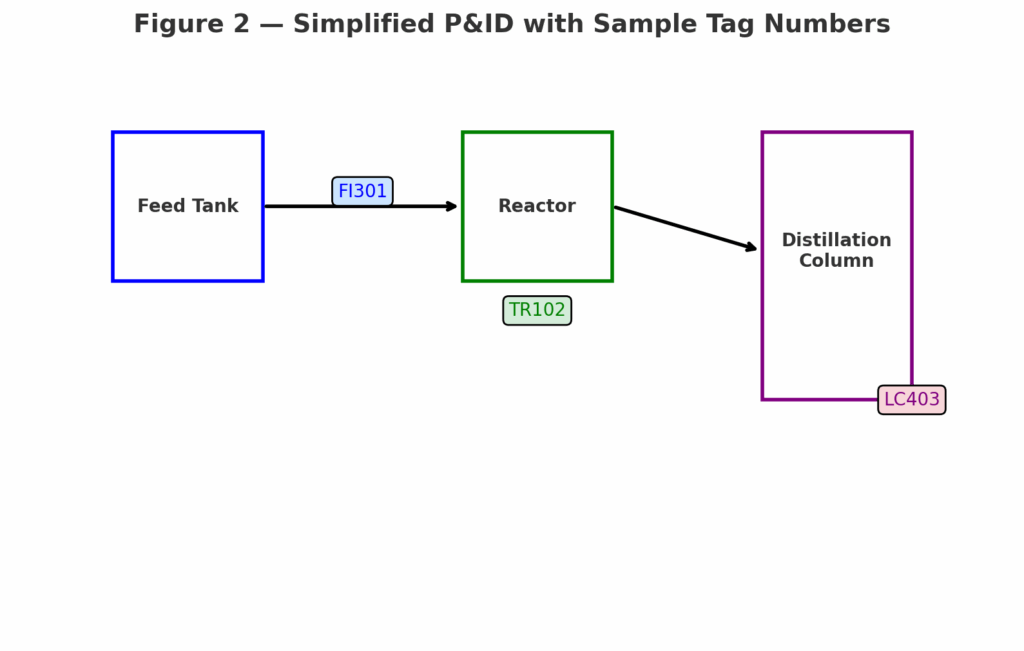Abstract
In modern industrial production, automation instruments are key tools for process monitoring, control, and safety assurance. To ensure accurate identification, rational arrangement, and efficient management of numerous instruments, the industry widely adopts instrument tag numbers as a standardized method of identification.
This article explains the significance of tag numbers, common compilation rules, international standards, and practical application cases.
1. Importance of Instrument Tag Numbers
1.1 Unique Identification
Each instrument requires a unique “ID card”—its tag number. With tag numbers, operators and maintenance staff can quickly locate instruments within large-scale installations, minimizing errors.
1.2 Fault Location and Maintenance
During operation, if an anomaly occurs, maintenance teams can rely on tag numbers to rapidly identify and repair or replace the faulty instrument, reducing downtime and improving plant safety.
2. Information Transfer and Management
2.1 Engineering Design Phase
Tag numbers form the basis for P&ID (Piping and Instrumentation Diagrams).
They define each instrument’s function, location, measurement parameters, and relationships with other equipment.
2.2 Production and Operation Phase
Operators use tag numbers in DCS/PLC interfaces to monitor process parameters and make precise adjustments.
2.3 Maintenance and Historical Records
Tag numbers serve as key indexes in asset management systems, linking to equipment files, maintenance logs, and replacement records.
3. Standardization and Norms
3.1 Industry Standards
ISA 5.1 “Instrumentation Symbols and Identification”
China’s Chemical Process Control Design Code
These ensure cross-vendor compatibility, unified design practices, and better project execution.
3.2 Data Integration and Smart Manufacturing
In the context of Industry 4.0, standardized tag numbers enable data integration across systems (DCS, MES, ERP), supporting digital twins and advanced analytics.
4. Common Tag Number Compilation Rules
4.1 Basic Structure
Letter Codes (measured variable or function):
Temperature (T), Pressure (P), Flow (F), Level (L), Analysis (A)
Function Codes (instrument role):
Indicator (I), Recorder (R), Controller (C), Alarm (A)
Table 1 — Common Instrument Letter Codes and Functions
| Measured Variable / Function | Letter Code | Description |
|---|---|---|
| Temperature | T | For sensors, transmitters, and controllers measuring temperature |
| Pressure | P | For pressure-related instruments (gauge, transmitter, controller) |
| Flow | F | For flowmeters, flow indicators, and flow controllers |
| Level | L | For level transmitters, indicators, and controllers |
| Analysis (Chemical/Composition) | A | For analyzers such as pH, oxygen, or gas analyzers |
| Indicator | I | Device showing real-time measurement (local or panel display) |
| Recorder | R | Device recording measured values (chart, digital, or electronic) |
| Controller | C | Device controlling a variable automatically |
| Alarm | A | Device giving audible/visual alerts when exceeding limits |
| Transmitter | T (suffix) | Device transmitting a signal to a control system |
| Switch | S | Device switching ON/OFF state based on measurement |
| Relay / Interlock | L | Device linked to safety or process interlock logic |
4.2 Numbering Methods
Process Sequence Numbering: TI101, TI102 …
Equipment-Based Numbering: T-RF101 (temperature on reactor RF101)
Area-Based Numbering: A-101 (instrument no.101 in Area A)
4.3 Special Cases
Multivariable instruments: TPI601 (Temperature/Pressure Indicator)
Interlock instruments: PIL701 (Pressure Interlock Instrument)
5. Examples of Common Tags
Temperature Instruments: TI101 (Indicator), TR102 (Recorder), TC103 (Controller)
Pressure Instruments: PI201, PR202, PC203
Flow Instruments: FI301, FR302, FC303
Level Instruments: LI401, LR402, LC403
Analysis Instruments: AI501 (pH), AO502 (Oxygen content)
Multivariable: TPI601, FLI602
Interlock: PIL701, TIL702

6. Practical Application Case
In a distillation unit of a chemical plant:
FI301 monitors feed flow.
TR102 records reactor temperature.
LC403 controls bottom level in the separation tower.
Operators can quickly trace alarms and take corrective actions through tag numbers.

7. Conclusion
Instrument tag numbers are more than a coding system—they are the management link that integrates identification, information transfer, lifecycle management, and data integration.
In the era of smart factories, well-structured and standardized tag numbers are essential to achieving safety, efficiency, and digital transformation.
